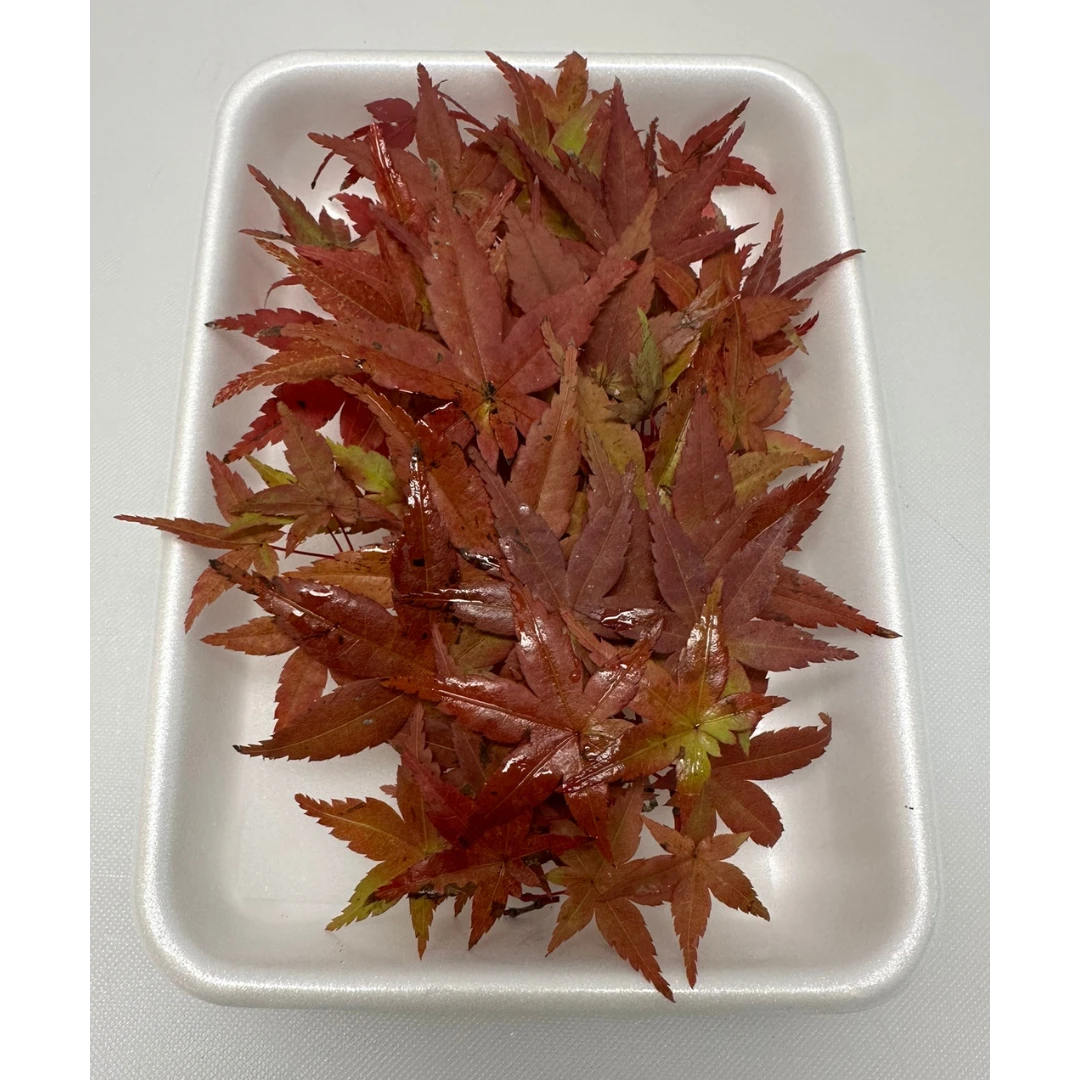MOMIJI - JAPANESE MAPLE LEAF - Acer palmatum

Description
もみじ MOMIJI - JAPANESE MAPLE LEAF - Acer palmatum
Variants
Green or Red available now.
Please click Variant drop down menu to choose your preferred color!
Location
Shizuoka
Size/Weight
30g /Pack
Texture/Flavor Profile
Momiji leaves are primarily ornamental, offering a soft, delicate texture. They have a crisp feel when fresh and dried, making them ideal for adding a touch of elegance to plates. While not used for flavor, they provide a subtle hint of autumn and a visual representation of Japan's changing seasons.
Availability/Seasonality
The vibrant red and orange hues of Momiji leaves are most stunning in autumn, from late September to November. Chefs should look to source these leaves during this peak season to capture their full beauty. However, preserved or dried leaves can be used year-round for decoration.
About
Scientific Name: Acer palmatum. In Japan, Momiji is revered for its striking colors and deep cultural significance, often representing autumn's beauty and the passage of time. These leaves, cherished in Japanese gardens for centuries, symbolize patience, beauty, and the cycle of nature. Momiji leaves have been used in Japanese cuisine and arts since the Nara period (710-794).
Preparation
Momiji leaves are best used fresh for decoration, adding an authentic touch to sashimi platters, bento boxes, and high-end sushi presentations. For an extra twist, try tempura-frying the leaves for a crunchy garnish, a delicacy in certain regions of Japan. These leaves pair wonderfully with elegant dishes, enhancing their visual appeal.
Nutritional Value
While Momiji leaves are not typically consumed for nutrition, they contain minimal calories and carbohydrates. Their primary role is to elevate the dining experience, contributing aesthetic value rather than dietary benefits.
Selection and Storage
Select vibrant, intact leaves without blemishes to ensure the highest quality presentation. Store fresh leaves in a damp cloth or paper towel inside a refrigerator to maintain moisture. Dried leaves should be kept in an airtight container away from light to preserve their color and texture.
Summary
Momiji leaves are a quintessential element of Japanese culinary art, symbolizing the beauty of autumn. Their deep reds and intricate shapes bring a touch of nature to any dish, making them a favorite among chefs for elegant plating. Incorporating Momiji adds authenticity and tradition, transforming meals into true works of art.
Variants
Green or Red available now.
Please click Variant drop down menu to choose your preferred color!
Location
Shizuoka
Size/Weight
30g /Pack
Texture/Flavor Profile
Momiji leaves are primarily ornamental, offering a soft, delicate texture. They have a crisp feel when fresh and dried, making them ideal for adding a touch of elegance to plates. While not used for flavor, they provide a subtle hint of autumn and a visual representation of Japan's changing seasons.
Availability/Seasonality
The vibrant red and orange hues of Momiji leaves are most stunning in autumn, from late September to November. Chefs should look to source these leaves during this peak season to capture their full beauty. However, preserved or dried leaves can be used year-round for decoration.
About
Scientific Name: Acer palmatum. In Japan, Momiji is revered for its striking colors and deep cultural significance, often representing autumn's beauty and the passage of time. These leaves, cherished in Japanese gardens for centuries, symbolize patience, beauty, and the cycle of nature. Momiji leaves have been used in Japanese cuisine and arts since the Nara period (710-794).
Preparation
Momiji leaves are best used fresh for decoration, adding an authentic touch to sashimi platters, bento boxes, and high-end sushi presentations. For an extra twist, try tempura-frying the leaves for a crunchy garnish, a delicacy in certain regions of Japan. These leaves pair wonderfully with elegant dishes, enhancing their visual appeal.
Nutritional Value
While Momiji leaves are not typically consumed for nutrition, they contain minimal calories and carbohydrates. Their primary role is to elevate the dining experience, contributing aesthetic value rather than dietary benefits.
Selection and Storage
Select vibrant, intact leaves without blemishes to ensure the highest quality presentation. Store fresh leaves in a damp cloth or paper towel inside a refrigerator to maintain moisture. Dried leaves should be kept in an airtight container away from light to preserve their color and texture.
Summary
Momiji leaves are a quintessential element of Japanese culinary art, symbolizing the beauty of autumn. Their deep reds and intricate shapes bring a touch of nature to any dish, making them a favorite among chefs for elegant plating. Incorporating Momiji adds authenticity and tradition, transforming meals into true works of art.




